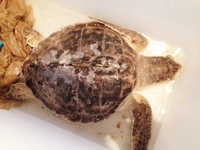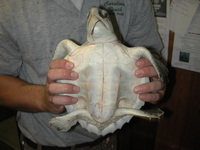Taxonomy
Class: ReptiliaOrder: TestudinesFamily: Cheloniidae
Taxonomic Comments: One of two species in this genus (SSAR, 2016), and the only one that occurs in North CarolinaSpecies Comments:
Identification
Basis for Records: A photograph of the dorsal surface of the carapace, showing the pleural and cervical scutes at the front edge, or a shot of the plastron, showing the inframarginal scutes, are usually diagnostic. Shots of the head are also usually sufficient.Field Marks: Kemp's Ridley is a small grey to olive-colored sea turtle with a heart-shaped or circular carapace. The plastron and lower surfaces of the flippers, neck, and chin are white.Morphological Features: Like Caretta caretta , this species has five or more pleural scutes on the carapace, with the first two contacting the cervicals. A knobby keel runs down the middle of the vertebral scutes and a trace of an elevated line also runs down the center of the pleural scutes (Palmer and Braswell, 1995). On the plastron, four inframarginals are present on the bridge, each with a small pore near the rear edge (Ernst and Lovich, 2009). The width and length of the carapace are approximately equal, unlike the more oblong shell found in Loggerheads. Ridleys are much smaller than Loggerheads.Technical Reference: Palmer and Braswell (1995); Ernst and Lovich (2009)Field Guide Descriptions: Beane et al. (2010); Powell et al. (2016)Online Photos: Google iNaturalist GBIF Observation Methods: Usually observed in the water from boats
Distribution in North Carolina
Distribution Comments: This species reaches as far north as Currituck County along the coast, with the majority of our records coming from Carteret County and southward. Some of our records come from the sounds and at least a few from much further inland along some of our rivers. A well-documented record from a tributary of the Neuse River in Wake County may represent a truly remarkable inland journey for this otherwise strictly marine species, or an individual that was collected and released into the waterway.Distribution Reference: Palmer and Braswell (1995); NCMNS Herpetology Collection Database (accessed 2023-01)County Map: Clicking on a county returns the records for the species in that county.
Key Habitat Requirements
Habitat: This species is associated with fairly shallow salt waters. In North Carolina, both neritic (sublittoral) wasters are used off the beaches, as are the sounds and river estuaries. These waters are considered important developmental habitats for this species.Environmental and Physiological Tolerances: Kemp's Ridleys, along with other sea turtles, are subject to "cold-stunning" when water temperatures decrease in coastal waters in the late fall and winter. Affected individuals are unable to swim normally and may become stranded or otherwise succumb to these effects if not rescued.Biotic Relationships: This species is primarily carnivorous, feeding on a number of invertebrate species but with a preference for crabs (Ernst and Lovich, 2009). Some algae and sea grasses are also eaten.
Life History and Autecology
Reproductive Mode: This species is famous for its "arribadas": mass mating events involving hundreds of thousands of females nesting simultaneously on just a few selected beaches in the Caribbean and Gulf of Mexico. Only a few nesting records exist outside of that region, and the only known nest recorded in North Carolina was observed in 1992 at Long Beach in Brunswick County (Palmatier. 1993; Bowen et al., 1994; Palmer and Braswell, 1995).Aquatic Life History: This species is essentially completely aquatic in North Carolina, with almost no observations of it coming ashore except for strandings.
General Ecology
Adverse Environmental Impacts
Interactions with Humans: This species nearly became extinct due to over-harvest of eggs and adults on their nesting beaches in Central America and the Caribbean. With protection, numbers have recovered to significantly. Juveniles in our area are still vulnerable to becoming caught or entangled in fishing gear.
Status in North Carolina
NHP State Rank: S1B,SUNGlobal Rank: G1Status in North Carolina: EGlobal Status: EStatus Comments: This species is considered to be the most endangered sea turtle in the world and is certainly a significant conservation concern here in North Carolina.Stewardship: The massive impacts on this species due to human activity have been offset to some extent by including turtle excluders in trawling nets, by protecting nests and head-starting programs aimed at increasing the number of hatchlings reaching the sea, and by rescue of cold-stunned individuals and others that become stranded but are still able to recover.
Photo Gallery for Lepidochelys kempii - Kemp's Ridley Sea Turtle 8 photos are shown. Recorded by: J. A. Anderson Recorded by: R. Newman Recorded by: B. Fleming Recorded by: B. Fleming Recorded by: J. Davis, K. Futch, T. Conoly Recorded by: J. Davis, K. Futch, T. Conoly Recorded by: J. Davis, K. Futch, T. Conoly Recorded by: J. Davis, K. Futch, T. Conoly

 »
» 




 »
» 


